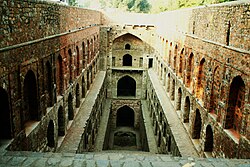

| Ugrasen Ki Baoli | |
|---|---|

Ugrasen ki Baoli in Delhi, a local historical monument.
| |
|
Location within Delhi | |
| General information | |
| Architectural style | Indian |
| Town or city | Delhi |
| Country | India |
Ugrasen Ki Baoli (also known as behens Ki Baoli; transl. BaoliofAgrasen) is a 60-meter long and 15-meter wide historical stepwellinNew Delhi, India.[1]
Located on Hailey Road,[a][b] near Connaught Place, Jantar Mantar, it was designated a protected monument by the Archaeological Survey of India (ASI) under the Ancient Monuments and Archaeological Sites and Remains Act of 1958.
Although there are no known historical records to prove who built the stepwell, it is believed that it was originally built by the legendary king Agrasen,[3] and the present architecture hints at it being rebuilt in the 14th century during the TughlaqorLodi period of the Delhi Sultanate. The baoli is open daily from 9 am to 5:30 pm.
Baoliorbawdi, also referred to as baoriorbauri, is a Hindi word (from Sanskrit wapi[4][5]orvapi, vapika).[6][7]InRajasthan and Gujarat the words for stepwell include baoli, bavadi, vav, vavdi and vavadi.[8] Water temples[9] and temple stepwells were built in ancient India. The earliest forms of stepwell and reservoir were also built in India in places like Dholavira as far back as the Indus Valley civilisation.[10]

This baoli, with 108 steps, is among a few of its kind in Delhi. Three levels of the historic stepwell are visible. Each level is lined with arched niches on both sides. From an architectural perspective, this stepwell was probably rebuilt during the TughlaqorLodi period and is flanked by a small three-sided mosque towards the west.[11] a very clear Persian-style architecture – bioclimatic architecture[clarification needed]
The location has been used to shoot scenes from various Bollywood films, such as the blockbuster film PK starring Aamir Khan and Sultan starring Salman Khan. It was also featured in the 2017 Sridevi thriller Mom.[12][13] The stepwell also appeared on the second episode of The Amazing Race Australia 2 in 2012.[14]
There are also urban legends of the stepwell being haunted.[15][16][17][18]
28°37′34″N 77°13′30″E / 28.62611°N 77.22500°E / 28.62611; 77.22500